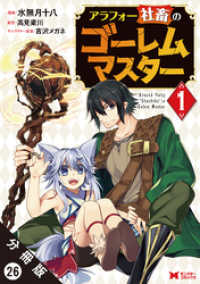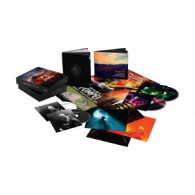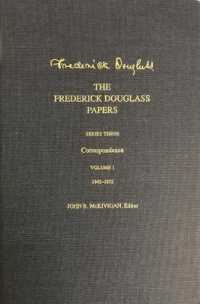Full Description
In 1916 anthropologist Gilbert L. Wilson worked closely with Buffalobird-woman, a highly respected Hidatsa born in 1839 on the Fort Berthold Reservation in western North Dakota, for a study of the Hidatsas' uses of local plants. What resulted was a treasure trove of ethnobotanical information that was buried for more than seventy-five years in Wilson's archives, now held jointly by the Minnesota Historical Society and the American Museum of Natural History in New York City. Wilson recorded Buffalobird-woman's insightful and vivid descriptions of how the nineteenth-century Hidatsa people had gathered, prepared, and used the plants and wood in their local environment for food, medicine, smoking, fiber, fuel, dye, toys, rituals, and construction.
From courtship rituals that took place while gathering Juneberries, to descriptions of how the women kept young boys from stealing wild plums as they prepared them for use, to recipes for preparing and cooking local plants, Uses of Plants by the Hidatsas of the Northern Plains provides valuable details of Hidatsa daily life during the nineteenth century.
Contents
List of IllustrationsPrefaceAcknowledgmentsIntroductionEditor's Note
Abbreviations: BBW=Buffalobird-woman; PW=Poor Wolf; GB=Goodbird; SW=Sioux Woman; GLW=Gilbert Wilson; WC=Wolf Chief; MS=Michael Scullin
1. Plants That Are EatenDomesticated plants (MS)Sunflowers (BBW)Corn-smut (BBW)Prairie turnips (BBW)Jerusalem artichokes (BBW)Hogpeanut (BBW, WC, GB)Chokecherries (BBW)Making stone hammers (BBW)Buffaloberries (BBW)Gooseberries (BBW)Black currants (BBW)Wild grapes (BBW)
2. Plants That Can Be EatenHawthorns (BBW)Wild white onions (BBW)Ball cactus (BBW, WC)
3. Plants That Are SweetJuneberries (BBW)White juneberries (BBW)Wild plums (BBW)Strawberries (BBW)Roses (BBW)Red raspberries (BBW, SW, GB)Biscuitroot (BBW)Nannyberries (BBW)Purple prairie clover (BBW)
4. Plants That Are Good to ChewSticky gum (BBW)Pine pitch (BBW)
5. Plants That Smell GoodPurple meadow-rue (BBW)Blue giant hyssop (BBW)Sweetgrass (BBW)Wild bergamot (BBW)Pine needles (BBW)Perfumes used in beds (BBW)Beaver musk (BBW)
6. Plants That Have Medicinal UsesBig medicine (BBW)White and red baneberry (BBW)Gumweed (WC)Purple coneflower (WC)"Medicine in the woods" (BBW)Poison ivy (BBW)Unknown grass (BBW, GB)Peppermint (BBW)
7. Plants Used for FiberDogbane (WC)Upright sedge (BBW)Grasswork ornaments on leggings (Isokikuas)
8. Plants Used for SmokingTobacco 9a (BBW)Tobacco 9b (WC)Red-osier dogwood (BBW)Bearberry (BBW)Bearberry or kinnikinnick (WC)
9. Plants Used for Dye and ColoringYellow owl's-clover (BBW)Water smartweed (BBW)Dye plants-unidentified (BBW)
10. Plants Used for ToysUmakixeke, or game of throwing sticks (BBW, GB)Popguns (BBW)A toy horseReed whistle (GB)
11. Plants Used for Utilitarian PurposesCordgrass (BBW)Buckbrush (BBW)Cattails (BBW)Box elder (BBW)Buffalograss (BBW)Big bluestem (WC)Common rush (BBW)Scouringrush horsetail (WC)Puffball (BBW)Snakewood (BBW, WC)Goldenrod (BBW)Prairie grasses as fodder (WC)
12. Plants Used for Rituals or with Ritual SignificanceThe three kinds of sage (WC)Pasture sage 1 (BBW, GB)Pasture sage 2 (BBW, WC)Common sagewort (BBW, WC, GB)Black sage (BBW, WC)Fringed sage (PW)Juniper (Cedar) (BBW, WC, GB)Creeping juniper (BBW, GB)Prairie sandreed (WC)Bittersweet (WC)
13. Sources of WoodWood as a resource (MS)Cottonwood (WC)Ash (BBW)Peachleaf willow (BBW)Sandbar willow (BBW, WC, GB)Heart-leaved willow (BBW)Quaking aspen (BBW)American elm (BBW)Water birch (BBW)Box elder (BBW)
14. Uses of WoodGathering firewood (WC)Digging-sticks (BBW, WC)Mortar and pestle (BBW)Making a bullboat frame (BBW)Making a wooden bowl (WC)Rakes (and the bison scapula hoe) (BBW, WC)Paddle for working clay pots (cottonwood bark) (GLW)
15. ArrowsSignificance and utility (MS)Making arrows (WC)Types of arrows (WC)Bows (WC)Arrows for boys (BBW, GB)Mock battle with grass arrows (WC)
16. EarthlodgesBuilding an earthlodge (BBW)On earthlodges (The observations of Hairy Coat and Not A Woman)Winter lodges and twin lodges (BBW)The peaked or tipi-shaped hunting lodge (BBW)The use of sod as an earthlodge coveringDismantling an old earthlodge (BBW)Like-a-Fishhook Village and environs (WC)
17. Miscellaneous MaterialBasket making (BBW)Native drinks of the Hidatsas (BBW)How our meals were served (GB)Nettles (BBW)Forest fire (GLW)
ConclusionAppendix: Frederick N. Wilson's Comments on "The Hidatsa Earthlodge"Bibliography








